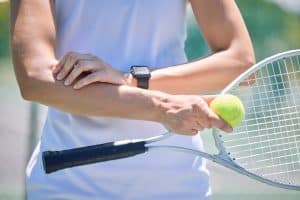The spring season mixed with warmer temperatures usually means athletes and sports. Popular activities can include soccer, tennis, baseball, softball, track and field, golf and lacrosse.

Spring sports can foster community and encourages an active lifestyle but also requires precautions. The transition from indoor to outdoor activities can sometimes lead to injuries if proper safety measures are not followed, especially during practice. Spring athletic injuries are not uncommon so it’s important to understand simple prevention measures and the role of musculoskeletal health in sports performance.
Common Spring Sports Injuries
-
Sprains and Strains
Sprains occur when ligaments (the tissues that connect bones to each other) are stretched or torn, while strains happen when muscles or tendons (which connect muscles to bones) are overstretched or torn. Both sprains and strains are common sports-related musculoskeletal (MSK) injuries in soccer, tennis and running. These injuries often result from overexertion, improper technique or lack of proper warm-up.
-
Ankle Injuries
Ankle sprains are particularly prevalent in sports like soccer, lacrosse and basketball where quick changes in direction and jumping are common. These injuries can range from mild ligament stretches to complete ligament tears, causing swelling, bruising and difficulty walking. Knowing sports injury prevention methods can help minimize such risks.
-
Knee Injuries
Patellar tendinitis (also known as “jumper’s knee”) and ACL (anterior cruciate ligament) tears are common knee injuries in sports such as soccer, basketball and running. These injuries can be caused by sudden, high-impact movements or improper landing mechanics. Understanding MSK injuries in sports is crucial to protect against these types of injuries.
-
Stress Fractures
Stress fractures, also known as small cracks in bones caused by repetitive stress are common in sports that involve a lot of running, like track and field, distance running and soccer. Stress fractures often affect weight-bearing bones in the foot. Spring sports and injury risks are heightened when athletes push themselves too hard without allowing time for proper recovery.
-
Tennis Elbow (Lateral Epicondylitis)
Tennis elbow is a common overuse injury in tennis, but it can also occur in other sports or activities involving repetitive motion of the elbow. Symptoms include inflammation of the tendons on the outer part of the elbow, causing pain and weakness in the arm. Sports injuries and prevention strategies can reduce the occurrence of this condition.
Prevention Techniques
-
Warm-Up and Stretching
A proper warm-up, including dynamic stretching, prepares the body for physical activity by increasing blood flow and flexibility. Static stretching after exercise can improve long-term flexibility and range of motion, reducing the risk of injury. Incorporating sports injury prevention techniques like these can keep athletes safe.
-
Proper Footwear
Wearing sport-specific shoes that provide the necessary support, cushioning and grip can help prevent injuries like ankle sprains or stress fractures. For example, soccer cleats are designed to offer stability, while running shoes are designed to absorb shock and provide proper alignment. Wearing the right shoes is a simple and effective way to help prevent MSK injuries in sports.
-
Strength Training
Strengthening key muscles around vulnerable areas like the knees, ankles and shoulders can help prevent injuries and can enhance support during running and jumping activities, reducing the risk of strains and sprains.
-
Gradual Progression
Another important point to highlight is the need to resist the urge to dive into intense physical activity too quickly. Whether you are running, playing tennis or engaging in another sport, gradually increasing intensity and duration allows the body to adequately adapt and prevents overuse injuries like stress fractures and tendinitis.
-
Proper Technique
Using proper technique in spring sports can reduce repetitive motion injuries. A coach or trainer can help identify areas where an athlete’s technique may need adjustment, especially for high-impact sports.
-
Rest and Recovery
Resting to prevent injuries and ensuring adequate recovery time are essential for protecting musculoskeletal health. Injury prevention through rest also plays a critical role in supporting long-term wellness and performance. Incorporating effective recovery strategies for athletes, such as rest days and injury prevention, significantly reduces the risk of overuse injuries. Recovery in athletic training is just as vital as the physical activity itself.
Conclusion
Spring sports offer an opportunity for physical activity but also come with the risk of injury. By understanding common injuries, following sports injury prevention techniques and respecting the role of the MSK system in sports, athletes can reduce the risk of harm and enjoy their favorite activities safely.
Northern Arizona Orthopaedics
The team at Northern Arizona Orthopaedics is ready to care for all your orthopedic and spine needs with multiple physicians specializing in all sub-specialties of bone, joint and spine care. Northern Arizona Orthopaedics is the largest orthopedic practice in the region, serving patients in Flagstaff, Prescott Valley and Pinetop-Lakeside. Let the trusted physicians at Northern Arizona Orthopaedics assist you in improving your activity, function and mobility by calling 928.226.2900 to schedule an appointment.
- Understanding Hip Labral Tears: Symptoms, Causes, and Treatment Options - December 3, 2025
- Kneecap Bursitis: Symptoms, Treatments, and Recovery in Flagstaff - October 23, 2025
- Jones Fractures: What Flagstaff Locals Should Know - September 30, 2025

